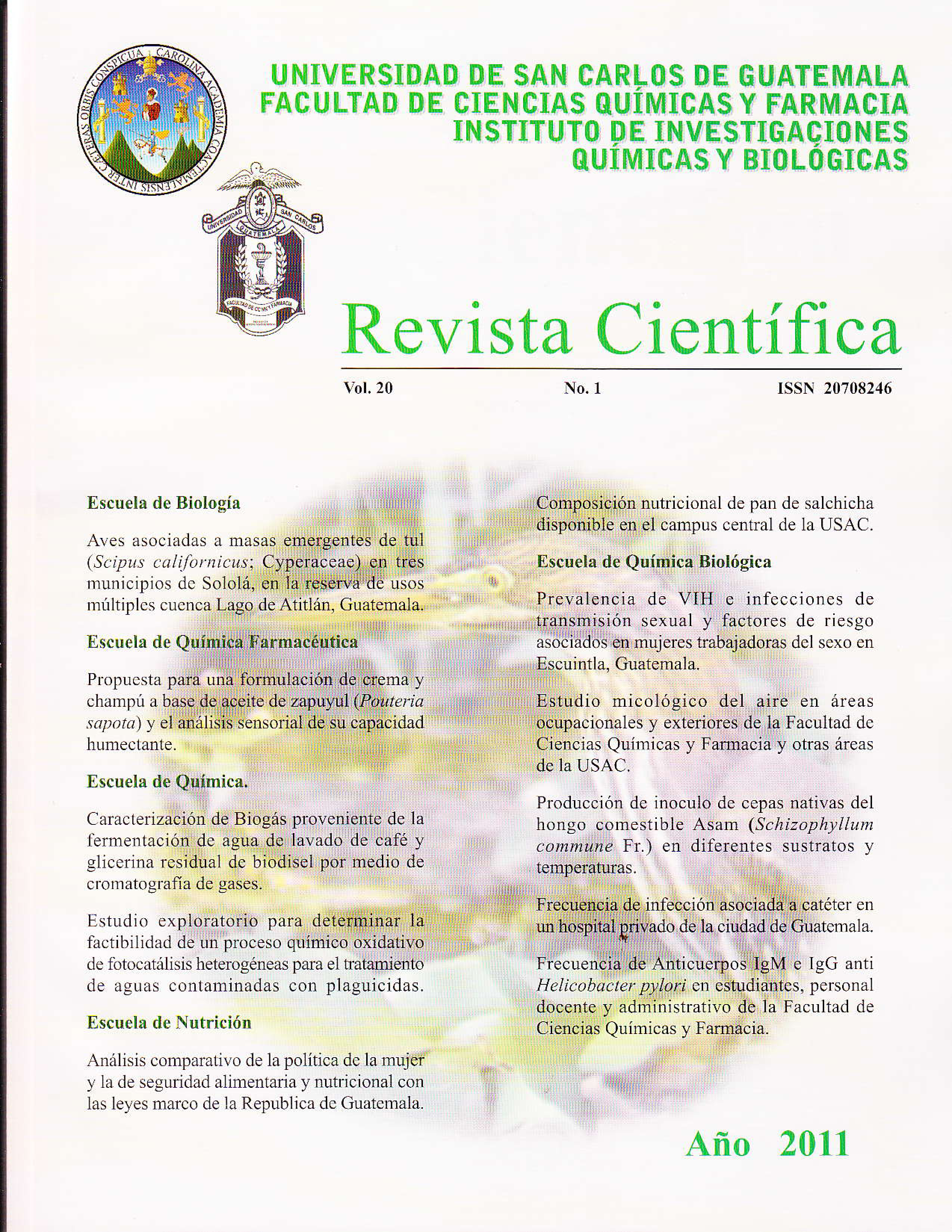Birds associated with emerging masses of tul (Schoenoplectus californicus: Cyperaceae) in three municipalities of Sololá, in the Lake Atitlán Basin Multiple Use Reserve, Guatemala
DOI:
https://doi.org/10.54495/Rev.Cientifica.v20i1.139Keywords:
Tul, nesting, aquatic ecosystems, Lake Atitlán, aquatic birds, Schoenoplectus californicusAbstract
Lake Atitlán is considered an important wetland water reservoir in Guatemala. The whole basin was declared as "Reserva de Usos Múltiples”, and it includes a variety of terrestrial and aquatic ecosystems. In the aquatic ecosystems there species known locally as “tul”, Schoenoplectus californicus (Cyperace) and Typha dominguenisis (Typhaceae), both of socioeconomic importance because they are used for handcrafts making. From both species of tul, S. californicus is the most abundant in the ecosystem. Currently, the Consejo Nacional de Áreas
Protegidas and civil organizations, are developing and designing tools for the management and monitoring of this natural resource, In our study we recorded bird species associated with emergent masses of S. californicus as inputs for the design of a biological monitoring program. We recorded eleven species associated to the mass of tul and 15 more species associated with surrounding aquatic ecosystems. Breeding. There was
reproduction activity recorded associated to S. californicus masses for the species of Oxyura jamaicensis, Fulica americana and Gallínula chloropus. The importance of aquatic ecosystems for survival of resident and migratory bird species was documented in this study in Atitlán lake.
Downloads
References
CONAP, (2007). Plan Maestro de la Reserva De Uso Múltiple Cuenca del Lago de Atitlán 2007-2011. Consejo Nacional de Areas Protegidas. Guatemala: CONAP
Dix, M., Mcdinilla, O., & Castellanos. E. (2003). Diagnóstico Ecológico-Socia] de la Cuenca de Atitlán. Universidad del Valle de Guatemala. The Nature Conservancy, Guatemala. Guatemala: Autor.
Dunn, J., & Aldereer, J. (2006). Field Guide to the Birds of North America. National Geographic Society; EEUU: National Geographic Society.
Eiscrmann, K. (2006). Evaluation of waterbird populations and their conservation in Guatemala. Guatemala: Autor.
Eiscrmann, K.. & Avendaño. C. (2007). Areas propuestas para la designación como TBA en Guatemala, con una priorización para la conservación adentro de las TBAs y una evaluación de las TBAs para aves migratorias Neárlicas-Neotropicales. Guatemala; Sociedad Guatemalteca de Ornitología,
Eisermann. K., & Avendaño, C. (2006). Diversidad de aves en Guatemala, una lista bibliográfica. En E. Cano. Biodiversidad de Guatemala (Vol. 1. págs. 525-623). Guatemala, Guatemala: Universidad del
Valle de Guatemala.
Howell, S., & Webb, S. (1999). A guide to the Birds of Mexico and Northern Central America. New York: Oxford University Press.
LaBastille, A. (1990). Mama Poc: An ecologist s account of the extintion of a species. WAV. Norton and company, New York.
Rappole, A.. King, D., & Barrow, W. ( 1 999). Winter ecology of the endangered Golden-checked Warbler. Condor , 762-770, https://doi.org/10.2307/1370063 DOI: https://doi.org/10.2307/1370063
Rappole, J., King, D., & Leimgruber, P. (2000). Wínter habitat and distribution of the endangered Golden-cheeked Warbler (Dendroica chrysoparía}. Animal Conservation, 2, 45-59, https://doi.org/10.1111/j.1469-1795.2000.tb00086.x DOI: https://doi.org/10.1111/j.1469-1795.2000.tb00086.x
Sarrias, A., Blanco, D., & López, J. (1996). Estructura de gremios de un ensamble de aves acuáticas durante la estación reproductiva. Ecología Austral, 6, 106-114.
Valle. L. (2002). Propuesta Técnica de Monitoreo de Aves en el Refugio de Vida Silvestre Bocas del
Poloehic. Fundación Defensores de la Naturaleza, The Nature Conservancy. Guatemala: Fundación Defensores de la Naturaleza.
van Perlo, B. (2006). Birds of Mexico and Central America (Princeton Illustrated Checklists). Princeton University Press.
Downloads
Published
How to Cite
Issue
Section
License
Copyright (c) 2011 M. Garcia, V. Dávila, B. Noriega

This work is licensed under a Creative Commons Attribution 4.0 International License.
Authors who publish with this journal agree to the following terms:
- Authors retain copyright and grant the journal right of first publication with the work simultaneously licensed under a Creative Commons Attribution License 4.0 that allows others to share the work with an acknowledgement of the work's authorship and initial publication in this journal.
- Authors are able to enter into separate, additional contractual arrangements for the non-exclusive distribution of the journal's published version of the work (e.g., post it to an institutional repository or publish it in a book), with an acknowledgement of its initial publication in this journal.
- Authors are permitted and encouraged to post their work online (e.g., in institutional repositories or on their website) prior to and during the submission process, as it can lead to productive exchanges, as well as earlier and greater citation of published work.









